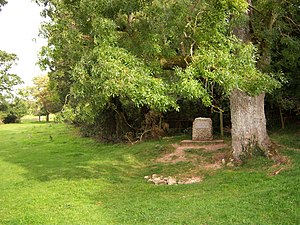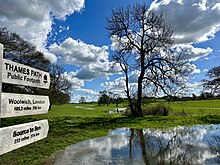51°41′39″N 2°01′47″W / 51.694262°N 2.029724°W / 51.694262; -2.029724


Thames Head is a group of seasonal springs that arise in the Cotswolds, in the county of Gloucestershire, England. Their location is in fields near the villages of Coates and Kemble, on either side of the A433 road, about three miles south-west of the town of Cirencester. The spring water comes from the limestone aquifers of the Cotswolds. One or more of these springs are traditionally identified as the source of the River Thames.
In actuality, the source of the River Thames does not have a fixed location – rather, it changes according to the level of the groundwater in the limestone. In dry periods, the groundwater level falls, causing the Thames Head springs to dry up and the river to begin lower down in its course. In wet conditions, the groundwaters rise and the river can begin at one of the Thames Head springs. The spring known as Lyd Well, located south of the A433 (grid reference ST989984), is often where the river starts. In 2011, the lowest recorded start of the Thames was just upstream of Ashton Keynes, which is over six miles (ten kilometres) downstream from Thames Head. During the 2022 United Kingdom heat wave, the source dried up completely, shifting five miles (eight kilometres) downstream to Somerford Keynes.
The highest springs of Thames Head are located north of the A433 road (Fosse Way section), in a meadow called Trewsbury Mead. One of these springs is marked with an inscribed stone marker, located 360 feet (110 m) above sea level at grid reference ST980994. Below it, the springhead itself is in a hollow that has been lined with stones. The springs continue immediately south of the A433.
The Ordnance Survey identifies Thames Head as the source of the Thames on its maps and the UK's Environment Agency follows their precedent. However, there is also a long-standing alternative view that the real source of the Thames is on a different headstream entirely: at Seven Springs, Gloucestershire, the source of the River Churn, which is officially a tributary of the Thames that joins the Thames at Cricklade and which is longer than the course of the Thames from Thames Head to Cricklade.

Marker stone
The marker stone in Trewsbury Mead bears the inscription:
THE CONSERVATORS OF THE RIVER THAMES
1857–1974
THIS STONE WAS PLACED HERE TO MARK THE
SOURCE OF THE RIVER THAMES
Thames source dispute
The source of the River Thames is disputed. The Environment Agency, the Ordnance Survey and other authorities have the source of the Thames as Thames Head. Others hold that the true source of the Thames is at Seven Springs, Gloucestershire, some 11 miles (18 km) farther north, and east of Gloucester. Seven Springs is officially the source of the River Churn, which is a tributary of the Thames that joins at Cricklade. As it is further from the mouth of the Thames than Thames Head, the adoption of Seven Springs as its source would make the Thames the longest river in the UK.
See also
References
- "Landscape around the Thames Head spring, the source of the river Thames in Gloucestershire". The National Archives. CC73/00044. Photo taken 1874, by Henry W. Taunt at Thames Head, Coates, Gloucestershire.
{{cite web}}: CS1 maint: postscript (link) - "The second spring of the Thames Head, located in Trewsbury Mead. A statue of Old Father Thames once stood in the field but was removed to Lechlade where the Thames becomes navigable to larger boats.(General view)". The National Archives. CC73/00041. Photo taken 1880, by Henry W. Taunt at Thames Head, Coates, Gloucestershire.
{{cite web}}: CS1 maint: postscript (link) - "A mole catcher at work in the field where the fourth spring of the Thames Head emerges. From here the river runs to Somerford Keynes and then on to Cricklade.(General view)". The National Archives. HT03070. Photo taken 1881, by Henry W. Taunt at Coates, Gloucestershire.
{{cite web}}: CS1 maint: postscript (link) - "View at the source of the River Thames at Thames Head showing the fourth spring and man beside the pump.(General view)". The National Archives. CC73/00534. Photo taken 1890, by Henry W. Taunt at Thames Head, Coates, Gloucestershire
{{cite web}}: CS1 maint: postscript (link) - Fort, Hugh (26 April 2020). "14 amazing facts about the Thames you probably never knew". Berkshire Live. Archived from the original on 28 April 2020. Retrieved 29 November 2020.
The source of the Thames is actually in a group of springs just north of the village of Kemble in Gloucestershire. There is a stone marking the official sources at Trewsbury Mead. The catch is the spring is mostly dry. However, the Thames Head group of springs is a few hundred metres away and this is where the water flows from.
- Thames Pathway Ch1, Accessed 15 August 2015
- "ABOUT COATES – Coates Parish Council". www.coatesparish.org.uk. Retrieved 28 November 2020.
- ^ Ross, David. "Thames Head, the Source of the River Thames". Britain Express. Archived from the original on 19 February 2020. Retrieved 28 November 2020.
- ^ Gordon, Emily (November 2011). Goody, Helen (ed.). "Achieving a healthy balance between People, Business and the Environment" (PDF). The Stripling (31). Upper Thames Protection Society: 1.
- Horton, Helena (4 August 2022). "Source of River Thames dries out 'for first time' during drought". The Guardian.
- ^ Dorothy Hart (9 May 2004). "Seven Springs and the Churn". The-river-thames.co.uk. Retrieved 17 May 2010.
- ^ BBC News, Gloucestershire. 15 May 2012 Could the River Thames be longer than the River Severn? by David Bailey
| River Thames, England | |
|---|---|
| Counties | |
| Source | |
| Mouth | |
| Selected settlements | |
| Major tributaries | |
| Estuary features | |
| Major crossings | |